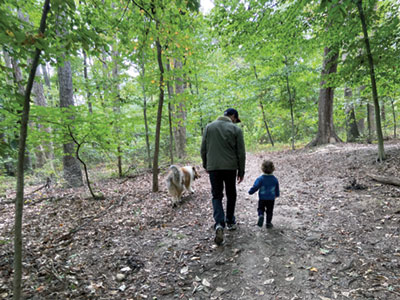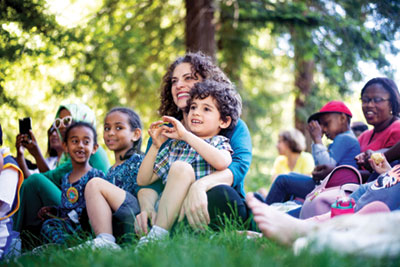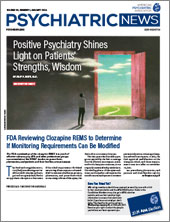When Nooshin Razani, M.D., M.P.H., was raising her two small children and working as a fellow in San Francisco, she found that both she and her children felt their best when they were outside. Without extended family nearby and with children with special needs, being outside offered a reprieve from everyday struggles.
Outdoor activities were hugely important for Razani’s kids. Yet it did not come without its challenges. “People would stop me in the park if my kids were barefoot because they were worried about them stepping on something dangerous, but my kids needed to be barefoot,” she said. They were even stopped while trying to walk on uneven terrain or down steep hills. “Climbing trees was completely avant-garde,” she said.
Razani is a pediatrician and the founder and director of the Center for Nature and Health at the University of California, San Francisco (UCSF). After her experiences with her own children, she launched a program that aims to reconnect children with the natural world through research and practical implementation.
A movement to better understand the impact that access to green space has on mental health has been
growing for decades. Among adults, research has linked green space with a reduced risk of a host of illnesses, such as
depression and dementia. Razani argued that physicians who work with youth are uniquely placed to advocate for access to nature as a clinical intervention.
“We focus a lot on prevention,” she said. “We also recommend very soft things in a hard way. For example, ample evidence points to the importance of strong attachment between a child and an adult. As clinicians, we talk about the concept of love and developing caring relationships within families all the time. For me, nature is our family. We have a right to establish relationships with nature in individual ways. It is a very evidence-based recommendation, but we don’t have to dictate how it happens.”
Disadvantaged Youth May Especially Benefit From Nature Access
A growing body of research investigates how children’s exposure to green space impacts the prevalence of different psychiatric disorders. Studies have found decreased rates of depression, anxiety, and attention-deficit/hyperactivity disorder when kids have access to green space, said Joshua Wortzel, M.D., M.Phil., a child and adolescent psychiatrist and chair of APA’s Committee on Climate Change and Mental Health.
“These are association studies, and the issue with any association study are the confounding factors,” Wortzel said. “Are we seeing these outcomes because kids who live near green spaces come from families who ... have more resources? With more research, though, we are seeing more and more that when researchers control for those things, green space still has a beneficial impact.”
A 2020 systematic review by Australian researchers published in PLoS One compared the psychological impacts of screen time among youth with what they called “green time,” defined as contact with nature. Though they noted that the measures for green space exposure were highly heterogeneous, overall they found that green time was associated with favorable psychological outcomes among youth aged up to 18 years, while screen time was associated with unfavorable outcomes. They also explained that these outcomes appeared strongest among youth from low socioeconomic backgrounds, though they also noted that socioeconomically disadvantaged youth are underrepresented in the literature.
They specifically pointed to one study that found that, in the absence of socioeconomic advantage, neighborhood green space may act as a protective factor against developing emotional problems. The 2014 study, published in the Journal of Environmental Psychology, found that disadvantaged children with a higher percentage of green space in their neighborhoods had fewer emotional problems from ages 3 to 5 years compared with similarly disadvantaged children with less green space in their neighborhoods.
How green space can especially benefit children from disadvantaged backgrounds is an area about which Cathy Jordan, Ph.D., is particularly passionate. Jordan is the director for leadership and education at the Institute on the Environment at the University of Minnesota and director of research for the Children & Nature Network, a national nonprofit aiming to increase children’s equitable access to natural spaces.
Jordan explained that many researchers believe nature has an “equigenic effect,” meaning that youth from low socioeconomic families benefit more from access to nature when looking at a range of outcomes compared with youth from more advantaged backgrounds.
In a 2021 study published in Wellbeing, Space, and Society, researchers investigated children’s social, emotional, and behavioral well-being; their family’s socioeconomic status; and the amount of green space they had available. The researchers used the Strengths and Difficulties Questionnaire to gather information on conduct problems and prosocial behaviors among 774 children aged 10 to 11 years in Scotland. Satellite images were used to determine the green space available in their neighborhoods. They found that a 10% increase in neighborhood green space was associated with reduction in emotional problem scores and an improvement in prosocial behavior scores. These benefits were especially strong among youth from lower income families.
“We shouldn’t be saying nature is just a luxury or that it’s O.K. that only the most advantaged kids who live near wonderful parks get to go there,” Jordan said. “We actually have enough information to say it’s potentially powerful enough that we would be remiss not to provide equitable access to all kids, especially those who have the most to gain.”
Turning Research Into Interventions
Organizations and programs like the Children & Nature Network and the Center for Nature and Health are putting into practice the robust body of research linking access to green space and positive mental health benefits among youth.
The Children & Nature Network has partnered with Casey Family Programs, a nonprofit organization that works with child welfare systems to help them develop best practices and policies to address the needs of the children and families they serve.
In 10 of the Casey Family Programs’ field offices, the Children & Nature Network works with their staff to enhance access to nature for youth in foster care. That largely looks like facilitating access, particularly through connections with local partners in each community to create more opportunities for not only children and families to get outdoors, but also for the social workers who serve them.
In 2012, UCSF’s Benioff Children’s Hospital Oakland partnered with the East Bay Regional Park District to integrate access to green spaces into outpatient primary care. On the first Saturday of every month, the park district and its foundation provide a free half day at the park, which includes transportation, a healthy lunch, and outdoor activities led by the park staff.
Razani noted that there is sometimes pushback against nature prescriptions, as many argue that a piece of paper from a doctor isn’t going to get patients outside. But the Stay Healthy in Nature Every day (SHINE) program facilitates patients’ access to the park, making it a great option for low-income families.
The children’s hospital also includes a question during well child visits asking families if the child has access to safe green spaces in which to play. “If clinicians think it’s indicated, they can then make a referral to SHINE, and the family can meet with our team,” Razani said. Each family is different: Some can benefit just from motivational interviewing on how they can get outdoors, but for others the SHINE program may be their only opportunity to access green space.
“Our goal is to let the kids play and let the parents relax,” she said. “It’s been an amazing experience. For over 10 years, thousands of youth have gone outside [as a result of the program]. Some kids come once, and some kids have come every month for 10 years.”
Razani and her colleagues have conducted several studies on SHINE and have found that each park visit decreases cortisol levels in both the child and parent, reduces loneliness and stress in the parents, and increases resilience in the children.
“What we have also found is that we don’t always need to facilitate the outings for patients to get the benefit of nature,” she said. “Even those who just spoke with a clinician about getting outside increased the number of times they went to parks on their own.” The findings were published in PLoS One in 2018 and Health and Place in 2019.
‘It Belongs to Everyone’
Within the last five years, the movement to connect or reconnect children with nature has gained even more momentum, Razani said. That’s understandable, because many people experience the benefits of nature in their own families on an emotional level. Yet Razani continues to emphasize the importance of focusing on research.
“We want to be careful in how we talk about it because if we try to be too broad and make too big of a claim about nature’s impact, some circles may view it as akin to snake oil, which is not true or appropriate,” she said. “If we are asking physicians to talk about nature during the 15 minutes they have with their patients, we need to justify that. We need evidence on how to implement this on a public health level to justify public time and dollars going toward it.”
Yet she also pointed to the real fear of overmedicalizing access to nature. “I want my research to be part of a movement that promotes the idea that access to nature is essential for children because it belongs to everyone, and there should be no gatekeeping associated with it,” she said. “It’s about reclaiming what humans have experienced for millions of years.” ■




